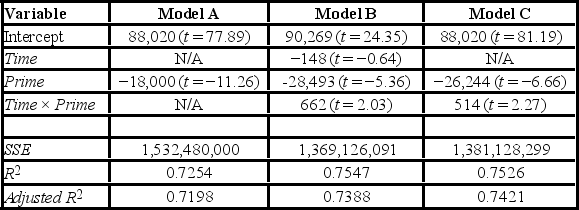Multiple Choice
A researcher wants to examine how the remaining balance on $100,000 loans taken 10 to 20 years ago depends on whether the loan was a prime or subprime loan. He collected a sample of 25 prime loans and 25 subprime loans and recorded the data in the following variables: Balance = the remaining amount of loan to be paid off (in $) ,
Time = the time elapsed from taking the loan,
Prime = a dummy variable assuming 1 for prime loans, and 0 for subprime loans.
The regression results obtained for the models:
Model A: Balance = β0 + β1Prime + ε
Model B: Balance = β0 + β1Time + β2Prime + β3Time × Prime + ε
Model C: Balance = β0 + β1Prime + β2Time × Prime + ε,
Are summarized in the following table.  Note: The values of relevant test statistics are shown in parentheses below the estimated coefficients.
Note: The values of relevant test statistics are shown in parentheses below the estimated coefficients.
Suppose that at the 5% significance level you do not reject the null hypothesis, H0: β1 = β3 = 0, when testing the joint significance of Time and Time × Prime in Model B. Should you delete both Time and Time × Prime from Model B?
A) No, because Model B has the highest R2.
B) No, because Model B reduces then to Model A with a lower adjusted R2.
C) No, because Model B reduces than to Model A with lower R2.
D) Yes, because Model B reduces than to Model C with higher adjusted R2.
Correct Answer:

Verified
Correct Answer:
Verified
Q58: A researcher wants to examine how the
Q59: A bank manager is interested in assigning
Q60: A bank manager is interested in assigning
Q61: In a model y = β<sub>0</sub> +
Q62: An over-the-counter drug manufacturer wants to examine
Q64: The number of dummy variables representing a
Q65: A medical researcher is interested in assessing
Q66: To examine the differences between salaries of
Q67: A logit model can be estimated with
Q68: Consider the model y = β<sub>0 </sub>+